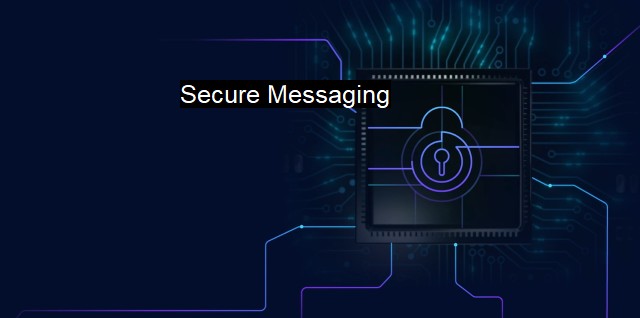What is Secure Messaging?
The Power of Secure Messaging: Protecting Sensitive Information in Cybersecurity and Antivirus
Secure messaging, in the context of cybersecurity and antivirus software, refers to the private communication system that ensures that only the sender and the receiver of a message can view it. The language of cybersecurity typically works around buzzwords like encryption, confidentiality, and integrity. These summarize what secure messaging stands for.Technology has always been a double-edged sword. While we try to expedite our communication, there's a constant threat of vital details slipping into the wrong hands. That's where secure messaging comes into play. Any lapse in secure communication can make personal or sensitive information susceptible to external threats, or cyber-criminals who are continuously striving to lower your shields.
Secure Messaging employs several encryption methodologies, the strongest one being the end-to-end encryption. In this method, the message gets encrypted, i.e., converted into a secret code at the sender's end, and only the receiver can decypher it. It signifies that even if someone intercepts a message in transit, they would lack the keys necessary to decode it.
Besides, secure messaging platforms vary from typical ones by the level of authoritative power they hand over to users. They give users more control over their messages once they have been sent. Think, for instance, of the ability to self-destruct or automatically deleting messages after a specified period. This feature is crucial in ensuring that sensitive data doesn't linger longer than required.
It's pertinent to know that most secure messaging platforms stand their ground on not storing user messages on their servers. They either don't save them at all or adequately encrypt them to protect against any potential infiltrations.
Not surprisingly, secure messaging is migratory, moving beyond personal communication. With remote work environments becoming increasingly common, businesses worldwide mandate to ensure that conversations, instructions, and shared files within their dial plate remain confidential. Secure messaging plays a pivotal role in cybersecurity strategies implemented by corporations.
Antivirus software often goes hand in hand with secure messaging. A comprehensive antivirus solution usually comes endowed with secure messages feature and likewise explicit security against spam and spyware. It helps protect against phishing attacks that cybercriminals use to get personal information like login or bank details.
In contrast, secure messaging platforms are safe haven from DDoS attacks. These attacks inundate a network with loads of fake traffic, attempting to crash the system and are widespread among cybercriminal activity. Since secure messaging applications rarely, if ever, rely on a centralized server, they're sheltered from such broad-scale attacks.
Lastly, it's significant to understand that no security system is unassailable. Threats continue to evolve and become more tamper-proof. employing secure messaging helps construct a substantial fortress around our confidential communications.
Tech firms are continuously working to introduce fresh and more potent forms of protection protocols like biometric authentication procedures. Though promising, the golden rule remains - one should think twice before sharing something of sensitive nature, irrespective of perceived security.
Secure messaging lies at the heart of information privacy. It engrains the idea that our discussions should remain just that - ours. The culmination of encryption techniques, antivirus software, and user discretion provide a much-needed shield in today's world where online predators continue to discover novel ways to wreak havoc.
Although, to ask the right questions regarding data privacy and the meticulous selection of antivirus programs can help individuals maintain cybersecurity hygiene – the ultimate step towards self-defense in the digital world. Whether in personal exchanges or managing business operations, secure messaging is no more an option; it is indeed a necessity.

Secure Messaging FAQs
What is secure messaging and why is it important in cybersecurity?
Secure messaging refers to the use of encryption and other security technologies to ensure that the content of messages is protected from unauthorized access or interception. It is important in cybersecurity because it helps prevent data breaches, protects sensitive information, and ensures that communication between individuals and organizations remains confidential and secure.What are some common features of secure messaging platforms?
Common features of secure messaging platforms include end-to-end encryption, two-factor authentication, message expiration, and the ability to retract or delete messages. These features help ensure that messages are only accessible to those who are authorized and prevent them from being compromised or intercepted by unauthorized parties.How can I determine if a messaging platform is secure?
To determine if a messaging platform is secure, you should look for information about the platform's security protocols, such as whether it uses end-to-end encryption, two-factor authentication, or other security measures. You can also look for reviews and ratings from cybersecurity experts and other users, as well as any certifications or third-party audits that the platform has undergone.What are some best practices for secure messaging?
Some best practices for secure messaging include using strong passwords, enabling two-factor authentication, avoiding public Wi-Fi networks, being cautious about clicking on links or downloading attachments, and regularly updating your software and security settings. It is also important to use a reputable and trusted messaging platform that prioritizes security and confidentiality.| | A | | | B | | | C | | | D | | | E | | | F | | | G | | | H | | | I | | | J | | | K | | | L | | | M | |
| | N | | | O | | | P | | | Q | | | R | | | S | | | T | | | U | | | V | | | W | | | X | | | Y | | | Z | |
| | 1 | | | 2 | | | 3 | | | 4 | | | 7 | | | 8 | | |||||||